Back in 2001 it was decided to visit England, Scotland and Wales and to delve into the history, architecture and culture of the country. What we discovered was an excellent way to do this, Living Outdoor Museums. This was the first Living Open-Air museum that I had ever visited and it started a search for additional ones during all future travels in the USA and Europe. Visiting one gives you the experience and a real sense of the past as you discover what life was like. Within the different buildings there usually are actors in period dress demonstrating the daily life of the time being depicted, while answering questions you might have and explaining what it was like living in those times.
Based on the Scandinavian folk museums the founder and first director, Dr. Frank Atkinson, saw in the 1950’s he came home to create a museum on the history of Northeast England that was being lost to new development and neglect. In developing this world famous open-air museum between Durham and Newcastle upon Tyne, Beamish (LINK) tells the story of ordinary people in northeastern England during the 1820’s, 1900’s and 1940’s. Opened in 1972 it rests on a 350-acre site in beautiful countryside and has been visited by Queen Elizabeth, The Queen Mother, in 1975 and Princess Anne in 2002. The buildings have been relocated, brick by brick, from around the region and then painstakingly rebuilt and furnished to give us a true sense of history.
 The museum consists of 6 areas depicting an 1820’s Landscape, a 1900’s town with Railway Station, a 1900’s Pit Village with a 1900’s Coffiery (coal mining town and mine) and a 1940’s Farm. Making your way counterclockwise around the museum will take you from the 1820’s thru the 1940’s. The Tramway around the site is 1.5 miles long and it is said it will take about 20 minutes to walk from the entrance to the Town, although I can not confirm that with all the stops I took along the way.
The museum consists of 6 areas depicting an 1820’s Landscape, a 1900’s town with Railway Station, a 1900’s Pit Village with a 1900’s Coffiery (coal mining town and mine) and a 1940’s Farm. Making your way counterclockwise around the museum will take you from the 1820’s thru the 1940’s. The Tramway around the site is 1.5 miles long and it is said it will take about 20 minutes to walk from the entrance to the Town, although I can not confirm that with all the stops I took along the way.
It is a large museum so there are trams and trolleys that circulate between the different areas. The Beamish Tramway will help you get around the museum if your time is short or do not wish stroll. This service re-creates the experience of tramway operations of an earlier generation. As well as the electric trams, there are replica Edwardian motorbuses, trolley buses and motorbuses to increase access around the site. I would recommend a full round trip for the experience of these older trolley cars and to just enjoy the scenery and atmosphere.
The Tramway Fleet consists of two Edwardian replica buses based on the London B type and a Northern General Daimler. A 2007 built accessible bus provides wheelchair access. There is only one working trolleybus, Newcastle 501. An Armstrong Whitworth replica car is also available as a limousine, and a supporting fleet of cars and vans dating from the 1920s to early 1960s can also be seen at work around the Museum.
1820’s Landscape, Pockerley Manor and Pockerley Wagonway
See how an 1820’s farm operated and how the farmers’ family lived.
 Visit Pockerley Old Manor, the ‘new house’ (1700’s), which is the home of the tenant farmer, then continue your visit in the 1440’s ‘old house’. Watch for traditional tasty Georgian cooking and craft activities inside the buildings. The “New House” consists of a main kitchen and scullery (pantry) and living area. The main kitchen is equipped with a modern, for the time, range, boiler and hot air oven. Upstairs is a main bedroom and secondary bedroom for the children and to the rear are the 2 servants bedrooms. The “Old House” was probably for the Farm Manager and has more sparse and older furniture. Next walk Pockerley Gardens a beautiful Georgian-era garden with plants, herbs and vegetables, which can often be sampled in the hall.
Visit Pockerley Old Manor, the ‘new house’ (1700’s), which is the home of the tenant farmer, then continue your visit in the 1440’s ‘old house’. Watch for traditional tasty Georgian cooking and craft activities inside the buildings. The “New House” consists of a main kitchen and scullery (pantry) and living area. The main kitchen is equipped with a modern, for the time, range, boiler and hot air oven. Upstairs is a main bedroom and secondary bedroom for the children and to the rear are the 2 servants bedrooms. The “Old House” was probably for the Farm Manager and has more sparse and older furniture. Next walk Pockerley Gardens a beautiful Georgian-era garden with plants, herbs and vegetables, which can often be sampled in the hall.
Take a short out and back nostalgic ride on the Pockerley Waggonway, a steam train that tells the story of the birth of the railways and is home to the replica engines Locomotion No.1, the Steam Elephant and Puffing Billy. Waggonways started as horse drawn trains in the 1600’s and later in the 1800’s turned to stream power. Get there early and sit in the front car to get a good look at how this waggonway engine operates. It was not crowded first thing in the morning and I was able to look inside the open engineers platform and take some photos.
Walk through the picturesque Georgian Landscape investigating the dry stonewalls, the oak fences, and traditional animals. Then finally peek inside the medieval church, St Helen’s, which is nestled in the landscape and was relocated from Eston. This church was due to be demolished due to vandalism until it was saved and rebuilt here and was found to have foundation stones dating to the 1100’s.
1900’s town
Explore town life during the 1900’s.
Inside Herron’s Bakery watch re-enactors use traditional recipes in working ovens to make delicious breads, cakes and biscuits. Then stop into the store where you can buy the tasty baked treats for a nice snack to take home or enjoy later as you wander around the grounds. There is a nice park at the end of the street to enjoy your bakery treats. Bakeries sprang up to supply the growing middle class in the cities with fresh baked goods and it does wonders for you with all the walking your doing.
 Needing repairs to your car, motorcycle or bicycle, then head to the Garage and see cars, motorcycles, bicycles, parts and tools of the period at the replica early 1900s garage, Beamish Motor & Cycle Works. An interesting place to explore for someone like me who has enjoyed working on these forms of transportation since Elementary School.
Needing repairs to your car, motorcycle or bicycle, then head to the Garage and see cars, motorcycles, bicycles, parts and tools of the period at the replica early 1900s garage, Beamish Motor & Cycle Works. An interesting place to explore for someone like me who has enjoyed working on these forms of transportation since Elementary School.
Need to do some shopping, head into the Co-op Store and search the grocery, drapery and hardware departments for what might be needed for the house. The building was moved from Annfield Plain, in County Durham.
 Walk into the past in the residences of Ravensworth Terrace and visit typical townhouses of the professional class which originally stood in Gateshead. Listen to the tales of the dentist’s surgery at the dentists house and office which consists of a exam room, surgical room and technician room with living quarters upstairs decorated in the more modern Edwardian style, visit the music teacher’s house next door decorated with old fashion Mid-Victorian furnishings and then see a traditional solicitors’ office.
Walk into the past in the residences of Ravensworth Terrace and visit typical townhouses of the professional class which originally stood in Gateshead. Listen to the tales of the dentist’s surgery at the dentists house and office which consists of a exam room, surgical room and technician room with living quarters upstairs decorated in the more modern Edwardian style, visit the music teacher’s house next door decorated with old fashion Mid-Victorian furnishings and then see a traditional solicitors’ office.
Ready for a pint or a snack then head to the Sun Inn, this traditional pub was moved to Beamish from Bishop Auckland to satisfy your food and drink needs.
Over at the Town Stables view the horse stables, tack house and carriage house that would have hired out horses and vehicles and see what a Jodmaster’s life is like.
 Need some stationary for a letter or a newspaper to catch up on the happenings around Beamish, then the Printer, Stationer & Newspaper Branch Office is where to go. Downstairs is the Sunderland Daily Echo, the Northern Daily Mail branch office, and stationer’s shop, here you can pick up some souvenirs of your visit . Upstairs in the printer’s shop check out the press in action and see where many of the posters around the museum are made.
Need some stationary for a letter or a newspaper to catch up on the happenings around Beamish, then the Printer, Stationer & Newspaper Branch Office is where to go. Downstairs is the Sunderland Daily Echo, the Northern Daily Mail branch office, and stationer’s shop, here you can pick up some souvenirs of your visit . Upstairs in the printer’s shop check out the press in action and see where many of the posters around the museum are made.
Ready for a sweet snack after all this exploring then the Sweet Shop will satisfy your craving. Watch the sweet treats being made in the factory before choosing which traditional treats to eat now or take home. YUMMY and remember the park.
See the coins, safes and strong-rooms in the Bank that keeps everything of value safe. Then Discover the Freemasons Masonic Hall featuring Masonic furnishings, objects and symbols of the time. Dedicated at it’s opening by Prince Edward, Duke of Kent the Grand Master of the United Grand Lodge of England.
Ready for an old time photo then visit W Smith’s Chemist and JR & D Edis Photographers for a picture taken in period clothing. The chemist and photographers shop include a dispensary and aerated waters section.
 Remember those snacks, drinks and sweets you purchased, well head over to Redman Park a beautiful spot to enjoy your snakes and take a rest. The bandstand originally from Saltwell Park in Gateshead regularly hosts live performances.
Remember those snacks, drinks and sweets you purchased, well head over to Redman Park a beautiful spot to enjoy your snakes and take a rest. The bandstand originally from Saltwell Park in Gateshead regularly hosts live performances.
Time for some far away travel then Rowley Station will be your next stop. See how a rail station looked in Edwardian times – enjoy a look around the signal box, waiting rooms and goods yard with a variety of wagons on display. The station was originally in Rowley, near Consett, County Durham, opened in 1867 it was reopened at Beamish in 1976 by poet Sir John Betjeman. Pass over the tracks on the wrought-iron footbridge from The Town that leads to the 1896 signal box. Across the tracks in the Goods Yard is a Goods Shed, dating from 1850. The coal drops from West Boldon reflect the important role of local coal merchants in towns and villages. The coal office, originally owned by James White of Hexham, is of a type which was found in almost every railway goods yard up to the late 1960s. A variety of wagons can be seen in and around The Railway Station, on a regularly changing pattern of display.
The Tram Depot
This is the workshop complex and includes accommodation for trams on roads 1, 2 3 and 4 and for cars, buses and trolleybuses on roads 4 and 5. Road 3 is equipped with the inspection and service pit. Here they provide routine maintenance, repairs, overhauls and complete restoration work.
1900’s Pit Village (Coal Mining Town)
Experience 1900’s life in a coal mining community at the time of peak coal production in the region.
On Francis Street explore miners’ cottages. No.2 is the Methodist family’s home, in No.3 lived a family of Irish descent, No.4 is home to a widow who lost her husband in a pit accident, and finally at the end is the Colliery Pay Office. Interesting to see how plain and sparingly the family lived in very small accommodations. With all the walking you have been doing look for the communal bread oven in the back lane you might be lucky and see some delicious homemade bread baking and hopefully some samples will be available. The residents used this oven for all their baking needs.
Need some learn’n, then School is in session. See how the 3R’s were taught in the 1900’s then during recess have fun trying some of the playground games. School was compulsory till the age of 12 and you learned by rote and corporal punishment (pretty strict back in the day).
After all this frivolity maybe a stop at the Pit Hill Chapel is in order. This was relocated from a nearby village and is typical of an early-1900s Methodist chapel.
At the Pit Pony Stables see the ponies and learn of their work down in the region’s mines.
1900’s Colliery (Coal Mine)
Sitting on the Durham Coalfeild the museum site shows how generations of families worked down in the pits, as this was the industry on which the region’s prosperity was built. Where children as young as 12 were hired but did not work underground until they reached 14. The work was well paid but very dangerous. Dig deep into the Mahogany Drift Mine where a trip down into the mine you will let you experience the hard, dark and dirty life these men endured working underground digging the coal in the shafts and tunnels. At the Winding Engine House see the sole surviving but once common 1855-built engine. The building next to the winding engine house, Heapstead, is where men, ponies and tubs were lowered into the mine and coal was brought up to be weighed and screened. Finally visit the railway network used by the mine owners at the Colliery Railway. This railway consists of standard and narrow gauge lines. The Engine Shed houses the Museum’s locomotives.
1940’s Farm
At the Farmhouse pop inside and find out about wartime family life on the farm. Presented as being modernized with electricity the Farmhouse has an Aga Cooker and heat storage appliance along with the older coal fired range. Linoleum flooring, for quick clean up and a radio set to hear the latest war news is also present in the house. Next door see how the laborers’ lived at the Orchard & Garden Cottages.
In the fields see how the farms played an important role during the war helping to save England from starvation during World War II. Look for tractors, tools, animals, the farmer’s out-of-use car, and the pill-box always ready in case of attack.
There is a lot to see and explore in this living time-capsule museum so I would give the visit most if not a full day to really explore the grounds. We visited in a little over 4 hours as some areas were closed to us at the time (see footnote below). Have fun and enjoy the history these outdoor museums provide.
FOOTNOTE – It was heartbreaking that Foot and Mouth (LINK) was prevalent during our visit in 2001. The gardens and farm areas were closed off to help stop the spread of this devastating disease. The outbreak decimated the agricultural and tourism industry of England. Cars were disinfected as you drove through affected areas and you had to walk through disinfecting mats to remove the disease from your shoes. Over 10 million cows and sheep where destroyed to help prevent further outbreaks. From what we saw beyond the gates and fences looked amazing.



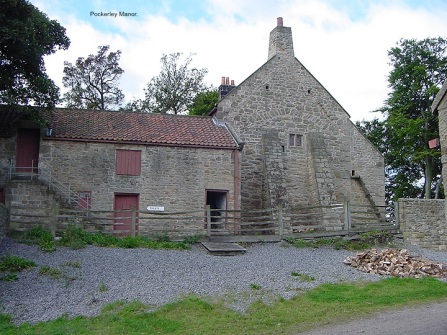




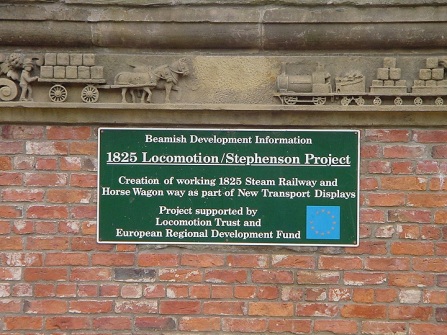
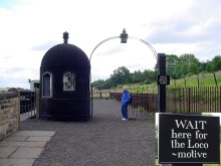

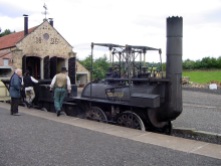





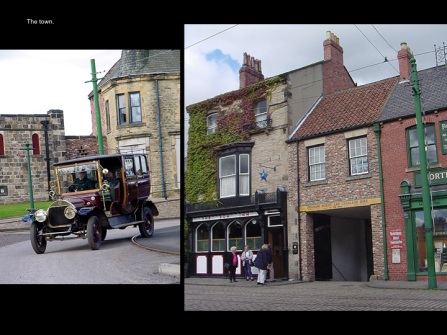

























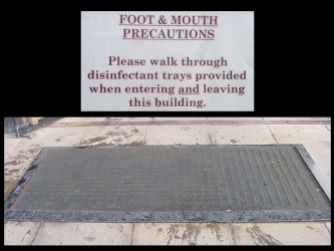

I like the farm houses…and the nestled feeling within the green…craving colour…wonderful living museum and I love these spaces too 😀
LikeLiked by 1 person
It was so nice just wish the circumstances would have been better, The Hoof and Mouth that was going around rally stopped us from going some places. But just another reason to go back.
Have a great week Hedy.
LikeLike
I visited Beamish with my parents on a childhood holiday a long time ago – loved it! Thank you for the memory nudge, we need to take our son back and visit this gem again. Really enjoyed your post.
LikeLiked by 1 person
From the posts you have written I know your son would enjoy it there. Glad I brought back happy memories to you.
LikeLiked by 1 person